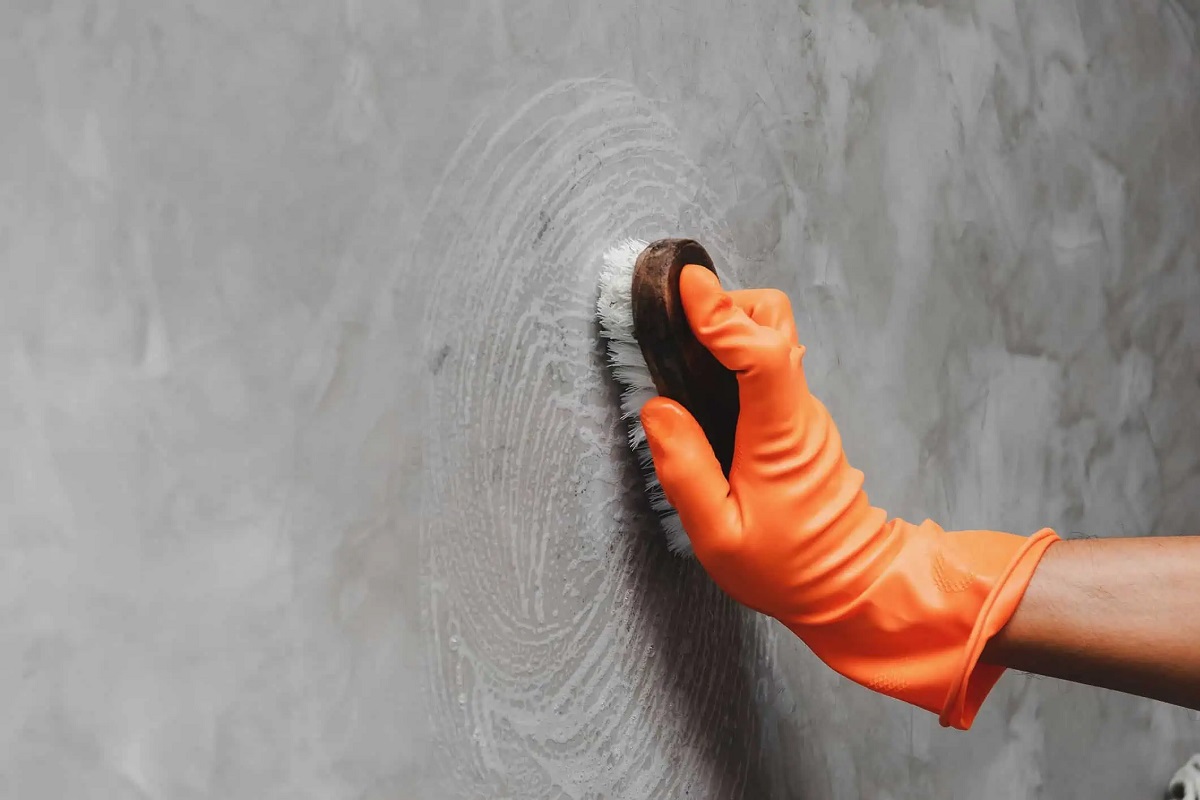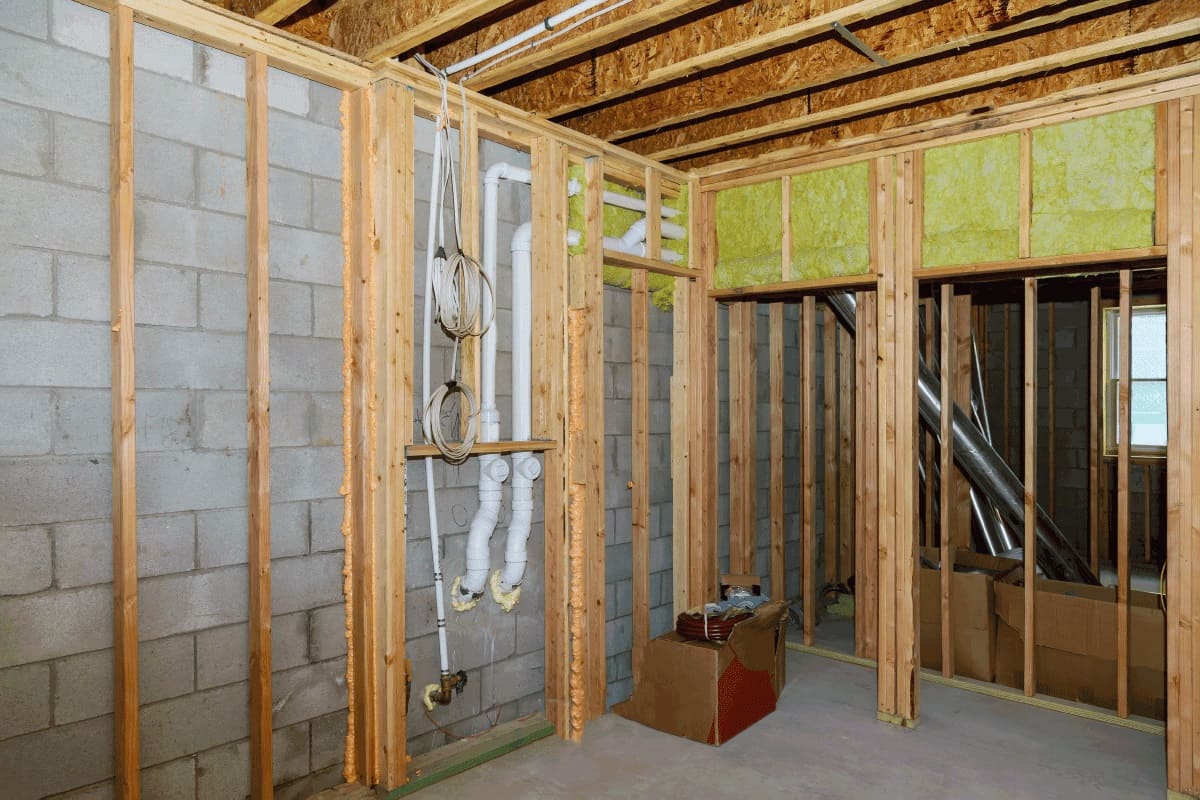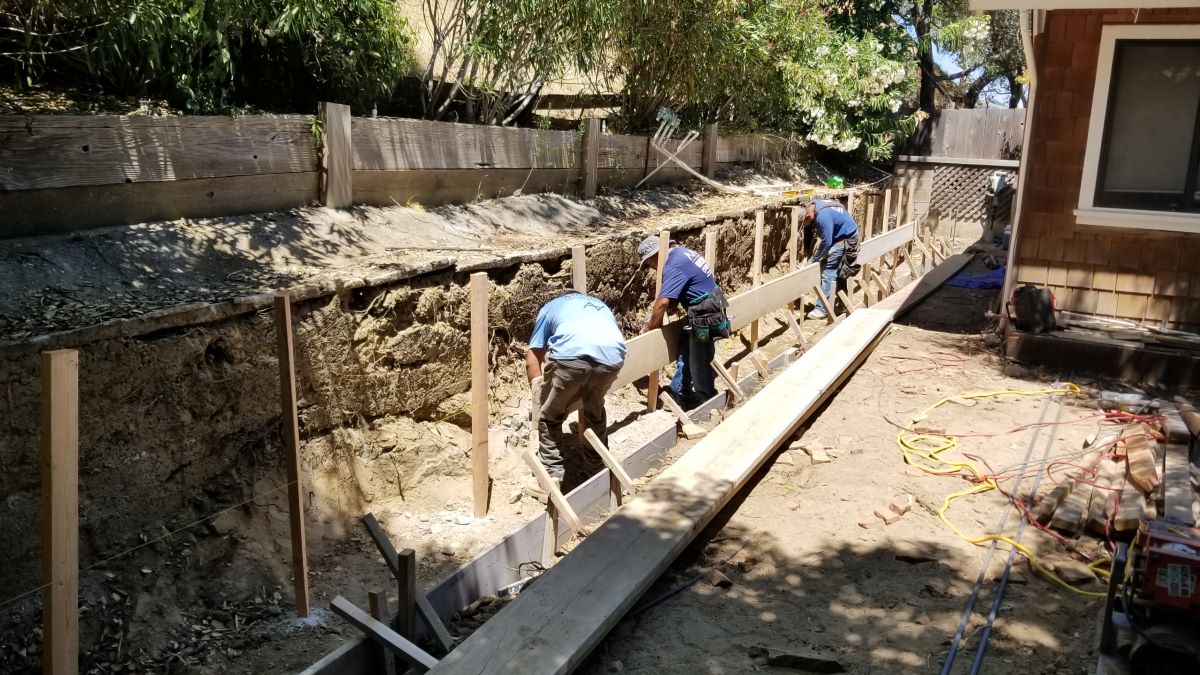

Articles
How To Clean Concrete Basement Walls
Modified: May 6, 2024
Learn effective methods and tips for cleaning concrete basement walls in this comprehensive articles. Say goodbye to stubborn stains and dirt once and for all!
(Many of the links in this article redirect to a specific reviewed product. Your purchase of these products through affiliate links helps to generate commission for Storables.com, at no extra cost. Learn more)
Introduction
Welcome to our comprehensive guide on how to clean concrete basement walls. Basements are notorious for accumulating dirt, dust, mold, and mildew over time. Cleaning concrete walls not only improves the appearance of your basement but also helps maintain a healthier and more pleasant environment.
Cleaning concrete walls may seem like a daunting task, but with the right tools and techniques, it can be a manageable and satisfying project. In this article, we will walk you through the step-by-step process of cleaning your concrete basement walls, from preparing the area to treating mold and mildew, removing stains, and ultimately achieving a clean and fresh-looking basement.
Before we delve into the cleaning process, let’s make sure you have all the necessary tools and materials:
Read more: How To Clean Concrete Basement Floors
Tools and Materials Needed
- Rubber gloves
- Protective eyewear
- Dust mask
- Stiff-bristle brush
- Sponge or scrub brush
- Broom or vacuum cleaner
- Bucket
- Waterproofing paint or sealer
- Concrete cleaner or degreaser
- Bleach or hydrogen peroxide
Now that you have gathered all the necessary tools and materials, let’s move on to preparing for the cleaning process.
Key Takeaways:
- Proper preparation, including gathering the right tools, protecting the area, and wearing safety gear, is essential before cleaning concrete basement walls. This ensures a safe and efficient cleaning process.
- After effectively removing dirt, mold, and stains, thorough drying and sealing of the walls are crucial for long-lasting protection and a clean, fresh basement environment. Regular maintenance is also key to preserving the walls’ condition.
Tools and Materials Needed
When it comes to cleaning concrete basement walls, having the right tools and materials is essential. Here is a list of what you’ll need to gather before starting the cleaning process:
- Rubber gloves: It’s important to protect your hands from any harsh chemicals or debris while cleaning.
- Protective eyewear: Safety should be a top priority, so make sure to wear goggles or safety glasses to shield your eyes from any potential splashes or flying particles.
- Dust mask: Concrete walls can generate a lot of dust, so wearing a mask will protect your lungs from breathing in any harmful particles.
- Stiff-bristle brush: A stiff-bristle brush will be your go-to tool for scrubbing away dirt, grime, and stains from the concrete walls.
- Sponge or scrub brush: A sponge or scrub brush will come in handy for cleaning smaller areas or hard-to-reach spots on the walls.
- Broom or vacuum cleaner: Before starting the cleaning process, it’s important to remove any loose dirt, debris, or cobwebs from the walls. A broom or vacuum cleaner with brush attachments will make this task easier.
- Bucket: You’ll need a bucket to mix your cleaning solution and hold water for rinsing.
- Waterproofing paint or sealer: Once the walls are clean, applying a waterproofing paint or sealer can help protect them from moisture and prevent future mold or mildew growth.
- Concrete cleaner or degreaser: A specialized concrete cleaner or degreaser will help break down and remove stubborn stains, oil, grease, or other residues from the walls.
- Bleach or hydrogen peroxide: These substances are effective for treating mold and mildew on concrete surfaces. Always follow the instructions on the product label for proper use.
By gathering these tools and materials, you’ll be well-equipped to tackle the task of cleaning your concrete basement walls. Now that you’re prepared, let’s move on to the next step: preparing for the cleaning process.
Preparing for the Cleaning Process
Before you begin the actual cleaning of your concrete basement walls, it’s important to take a few necessary steps to prepare the area. Follow these guidelines to ensure a smooth and efficient cleaning process:
1. Clear the Area:
Remove any furniture, storage items, or decorations that may be obstructing the walls. Creating an open space will allow you to have better access to the walls and ensure a thorough cleaning.
Read more: How To Clean Mold Off Basement Walls
2. Protect Surrounding Items:
Cover any items that cannot be easily moved, such as appliances, with plastic sheets or drop cloths. This will protect them from any splashes or drips that may occur during the cleaning process.
3. Ventilate the Area:
Basements can often be poorly ventilated, so it’s essential to create airflow during the cleaning process. Open windows and doors to allow fresh air to circulate, or use fans and air purifiers to improve ventilation and reduce the concentration of cleaning fumes.
4. Wear Protective Gear:
Ensure your safety by putting on rubber gloves, protective eyewear, and a dust mask. This will protect your hands, eyes, and respiratory system from any potential hazards such as chemicals, mold spores, or dust particles.
5. Test the Cleaning Solution:
If you’re using a concrete cleaner or degreaser, it’s important to test it on a small, inconspicuous area of the wall first. This will help you ensure that the solution doesn’t cause any damage or discoloration to the concrete surface.
Read more: How Thick Is Basement Concrete Floor
6. Read the Instructions:
Before using any cleaning products, carefully read and follow the instructions provided by the manufacturer. This will help you understand the proper dilution ratios, application methods, and safety precautions for the specific product.
By following these preparation steps, you’ll set the stage for a successful cleaning of your concrete basement walls. Now you’re ready to move on to the next step: removing dirt and debris from the walls.
Removing Dirt and Debris
Before diving into the deep cleaning process, it’s important to remove any loose dirt, dust, cobwebs, or debris from the concrete basement walls. Following these steps will help ensure a clean surface to work with:
1. Clear the Walls:
Start by using a broom or a vacuum cleaner with a brush attachment to gently sweep away any loose dirt, dust, or cobwebs from the walls. Pay attention to the corners and crevices where these particles tend to accumulate.
2. Dry Dusting:
If there are stubborn areas with excessive dust or cobwebs, you can use a dry microfiber cloth or a soft brush to gently wipe or brush them away. Be careful not to apply too much pressure, as you don’t want to scratch the surface of the concrete walls.
Read more: How To Put Up Drywall In Concrete Basement
3. Remove Spills and Stains:
If you come across any spills or noticeable stains on the walls, use a damp cloth or sponge to gently blot the area. Remember to use only water at this stage, as we will address stains later in the process.
4. Inspect for Damages:
While removing the dirt and debris, take a moment to inspect the walls for any signs of cracks, chips, or other damages. If you notice any significant damage, it may require additional repairs or attention before proceeding with the cleaning process.
5. Clear the Work Area:
After you have completed the dirt and debris removal process, remove any dust or debris from the immediate work area. This will prevent any loose particles from contaminating the cleaning solution or getting in your way during the next steps.
By following these steps, you’ve successfully cleared your concrete basement walls of dirt, dust, cobwebs, and loose debris. Now it’s time to move on to the next stage: treating any mold or mildew that may be present.
Treating Mold and Mildew
Mold and mildew can be common problems in basement environments, especially in areas with high humidity or moisture. To ensure a clean and healthy space, it’s crucial to address any mold or mildew growth on your concrete basement walls. Follow these steps to effectively treat and remove mold and mildew:
Read more: How To Finish Concrete Basement Floor
1. Safety Precautions:
Before tackling mold and mildew, make sure to wear rubber gloves, protective eyewear, and a dust mask to protect yourself from potential health hazards.
2. Ventilation:
Ensure proper ventilation in the area by opening windows and doors or using fans. This will help disperse any fumes or spores that may be released during the treatment process.
3. Mix a Cleaning Solution:
Create a cleaning solution by combining equal parts water and bleach or hydrogen peroxide. Both bleach and hydrogen peroxide have antimicrobial properties that can effectively kill mold and mildew.
4. Apply the Solution:
Dip a stiff-bristle brush or a sponge into the cleaning solution and gently scrub the affected areas of the concrete walls. Pay close attention to areas where you can visibly see mold or mildew growth.
Read more: How To Seal Concrete Basement Floor
5. Let it Sit:
Allow the cleaning solution to sit on the wall for a few minutes. This gives it time to penetrate the mold or mildew and break down its structure.
6. Scrub and Rinse:
After letting the solution sit, use the brush or sponge to scrub the mold or mildew spots more vigorously. Make sure to scrub in a circular motion to effectively remove the growth.
7. Rinse with Clean Water:
Once you’ve scrubbed the affected areas, rinse the walls thoroughly with clean water. This will help remove any residue left by the cleaning solution.
8. Repeat if Necessary:
If the mold or mildew persists, repeat the cleaning process until the walls are free from visible growth. In some cases, professional assistance may be required for severe mold or mildew infestations.
By following these steps, you can effectively treat and remove mold and mildew from your concrete basement walls. Once the mold and mildew are under control, you can move on to addressing any stubborn stains that may be present.
Read more: How To Stucco Concrete Walls
Removing Stains
Concrete basement walls can often be prone to stains, whether from water damage, spills, or other sources. To restore the appearance of your walls and remove any unsightly stains, follow these steps:
1. Identify the Type of Stain:
Before treating a stain, it’s important to identify its type. Common types of stains include oil and grease, rust, paint, or organic stains like coffee or wine. Different stain types may require different cleaning methods or products.
2. Preparing the Cleaning Solution:
Depending on the type of stain, prepare a suitable cleaning solution. Here are a few common options:
- Dish soap and warm water: A mild dish soap mixed with warm water can be effective for general stains.
- Vinegar: For mineral deposits or light stains, a mixture of vinegar and water can be used.
- Commercial concrete stain remover: If the stains are stubborn or specialized, consider using a commercial concrete stain remover. Follow the manufacturer’s instructions for proper use.
3. Apply the Cleaning Solution:
Using a sponge, cloth, or scrub brush, apply the cleaning solution to the stained areas of the concrete walls. Allow it to sit for a few minutes to penetrate the stain.
Read more: How To Repair Basement Walls
4. Scrubbing the Stain:
Gently scrub the stained areas with a stiff-bristle brush or sponge in a circular motion. Apply moderate pressure and work from the outer edges of the stain towards the center.
5. Rinse with Clean Water:
Rinse the cleaned area with clean water to remove any residue from the cleaning solution and the loosened stain. Thoroughly rinse until the water runs clear.
6. Repeat if Necessary:
If the stain persists, repeat the cleaning process with the same or a stronger cleaning solution. Some stubborn stains may require additional treatments or specialized stain removers.
7. Be Mindful of Acidic Cleaners:
Avoid using strong acidic cleaners, such as muriatic acid, on concrete walls as they can cause damage. Always follow the manufacturer’s instructions and exercise caution when working with chemicals.
By following these steps and using the appropriate cleaning methods, you can effectively remove stains from your concrete basement walls. Now that the stains are addressed, let’s move on to cleaning the walls thoroughly.
Read more: How To Drylok Basement Walls
Cleaning the Walls
Now that you’ve treated any mold, mildew, and stains on your concrete basement walls, it’s time to give them a thorough cleaning. Follow these steps to ensure a deep and effective cleaning:
1. Prepare a Cleaning Solution:
Create a cleaning solution by mixing a concrete cleaner or degreaser with water according to the manufacturer’s instructions. Alternatively, you can use a mixture of mild dish soap and warm water.
2. Wet the Walls:
Using a sponge or a spray bottle, wet the entire surface of the walls with the cleaning solution. Make sure to saturate the walls but avoid excessive soaking that could lead to pooling or dripping.
3. Scrub the Walls:
Using a stiff-bristle brush or a scrub brush, start scrubbing the walls from the top and work your way down. Use firm but controlled motions and apply consistent pressure to remove any remaining dirt, grime, or residues.
Read more: How To Parge Basement Walls
4. Pay Attention to Stubborn Areas:
If there are any particularly stubborn spots or stains, spend extra time and effort to scrub them more vigorously. You may need to use more cleaning solution and allow it to sit on the area for a few minutes before scrubbing again.
5. Rinse the Walls:
After scrubbing, rinse the walls thoroughly with clean water. This helps remove any residue from the cleaning solution and leaves the walls fresh and clean.
6. Dry the Walls:
Allow the walls to air dry, or use a clean towel or cloth to pat them dry. Ensure proper ventilation in the basement to aid in the drying process and prevent moisture buildup.
7. Inspect for Remaining Dirt and Stains:
Take a final look at the walls and inspect for any remaining dirt, stains, or areas that need further cleaning. If necessary, repeat the cleaning process or spot clean specific areas as needed.
By following these steps, you’ll achieve clean and refreshed concrete basement walls. Now, let’s move on to the final step: drying and sealing the walls to maintain their cleanliness and protect them from future damage.
Drying and Sealing the Walls
After cleaning your concrete basement walls, it’s important to properly dry them to prevent any moisture-related issues and then apply a sealant to protect and maintain the cleanliness of the walls. Follow these steps for effective drying and sealing:
1. Allow Sufficient Drying Time:
Before sealing the walls, ensure that they are completely dry. Depending on the temperature and humidity levels in your basement, this may take anywhere from a few hours to a few days. Use fans or dehumidifiers to expedite the drying process if needed.
2. Check for Moisture:
Before sealing, check for any signs of moisture on the walls. Look for damp patches, water droplets, or condensation. If any moisture is present, allow more time for the walls to dry completely before proceeding.
3. Choose the Right Sealant:
Select an appropriate sealant for your concrete basement walls. There are various types available, including waterproofing paints, concrete sealers, or masonry waterproofing products. Read the product labels and choose one that suits your specific needs and preferences.
Read more: How To Clean Concrete Balcony
4. Prepare the Sealant:
Follow the manufacturer’s instructions to prepare the sealant. This may involve mixing components, adding water, or shaking the product before application. Ensure that the sealant is well-mixed and ready for use.
5. Apply the Sealant:
Using a paint roller or a brush, start applying the sealant to the walls. Work in small sections, applying an even coat from top to bottom. Pay special attention to any cracks or porous areas that may require additional sealant for proper protection.
6. Allow Drying Time:
Allow the sealant to dry as per the manufacturer’s instructions. This typically takes a few hours or overnight, depending on the product. Ensure proper ventilation in the basement to aid in the drying process.
7. Apply Additional Coats if Needed:
If necessary, apply additional coats of sealant to enhance the protection and durability of the walls. Follow the manufacturer’s recommendations for the number of coats needed and the drying time between each application.
Read more: How To Clean A Concrete Porch
8. Revisit Regularly:
Regularly check the condition of the sealed walls and reapply the sealant as needed, depending on the wear and tear and the specific instructions of the product used.
By following these steps, you’ll ensure that your concrete basement walls are thoroughly dried and sealed, providing long-lasting protection and maintaining their cleanliness. With the cleaning and sealing process complete, you can now enjoy a clean and fresh basement environment.
Conclusion
Cleaning concrete basement walls may seem like a daunting task, but with the right approach and techniques, you can achieve a clean and fresh environment. By following the step-by-step process outlined in this guide, you’ll be able to effectively remove dirt, debris, mold, mildew, stains, and protect your walls for years to come.
Start by gathering the necessary tools and materials, ensuring you have everything you need to begin the cleaning process. Preparing the area and protecting yourself with safety gear are crucial steps to create a safe and efficient work environment. Next, take the time to remove any loose dirt and debris, as well as treating any mold and mildew that may be present.
Stubborn stains can be a challenge, but with the right cleaning solution and techniques, you can effectively remove them from your concrete basement walls. Scrubbing the walls thoroughly and rinsing them clean will ensure a pristine finish.
Once the cleaning process is complete, it’s important to allow the walls to dry thoroughly before applying a sealant. The sealant not only enhances the appearance of the walls but also provides protection against moisture and helps maintain their cleanliness over time.
Remember to inspect your walls regularly and address any maintenance or cleaning needs as necessary. By taking proactive measures and periodically cleaning and sealing your basement walls, you can keep them in optimal condition and create a healthier and more inviting space.
We hope that this comprehensive guide has provided you with valuable insights on how to clean concrete basement walls effectively. With the knowledge and techniques gained from this article, you can confidently tackle the task of maintaining a clean and beautiful basement environment.
Now that you've got the knack for keeping those concrete basement walls spotless, why not ensure they stay in top condition over time? Tackling moisture issues is key, and our next guide on basement waterproofing provides all the necessary steps to keep your space dry and protected. Discover practical waterproofing techniques that will prevent future complications, ensuring your basement remains a strong, clean foundation for your home.
Frequently Asked Questions about How To Clean Concrete Basement Walls
Was this page helpful?
At Storables.com, we guarantee accurate and reliable information. Our content, validated by Expert Board Contributors, is crafted following stringent Editorial Policies. We're committed to providing you with well-researched, expert-backed insights for all your informational needs.




0 thoughts on “How To Clean Concrete Basement Walls”